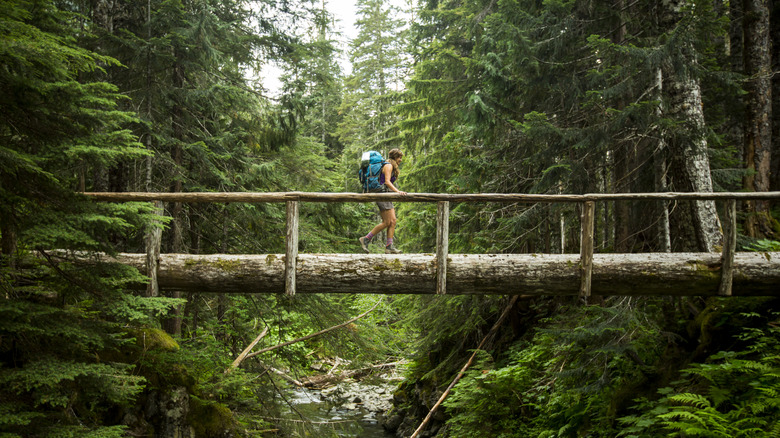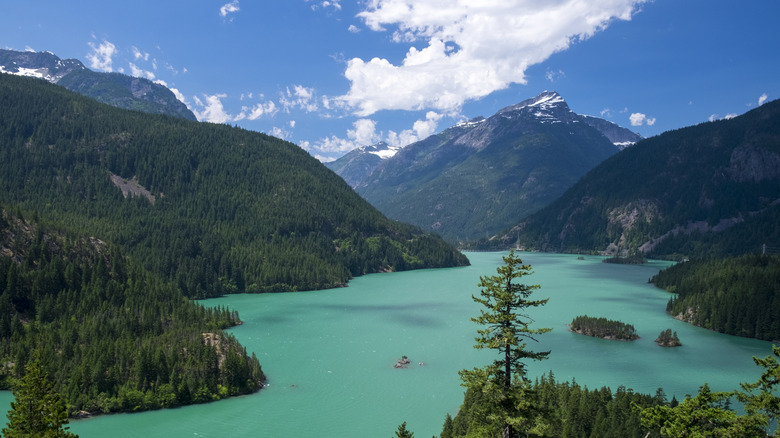Why All Three Of Washington's National Parks Should Be On Your Bucket List
Determining which national parks should be on your bucket list can be both inspiring and frustrating. It's tough to decide which natural wonders sound most wonderful when there are so many contenders in the United States alone. Exploring several stunning parks in the same region can help you get the most bang for your buck (or bucket list). The Pacific Northwest is an ideal place to try this strategy. All three of Washington's national parks — Olympic, Mount Rainier, and North Cascades — deserve a spot on your list, and they offer lots of variety despite being a few hours apart.
In case you're wondering, the drive from Olympic to Mount Rainier is 208 miles, and from Mount Rainier to North Cascades is 204 miles. That means you'll spend half a day traveling from one park to another in typical traffic and weather. If you live near any of these parks or have several weeks set aside for an adventure, you may be able to see all three in one trip. If that's not possible, each of these parks is certainly worthy of a standalone visit.
Though Olympic, Mount Rainier, and North Cascades differ in many ways, they share one major feature: mountains. If snow-capped peaks and ancient volcanoes make you bubble with excitement, you'll want to experience them up close and learn how they came to be. Washington's national parks offer chances to view their majesty from numerous angles, as well as hike their trails, climb their boulders, and ski their glorious slopes.
Olympic's temperate rainforests are as quiet as they are green
Olympic National Park is a bastion of biodiversity thanks to its widely varied habitats and many elevation shifts. It's home to more than 300 species of birds, 70 types of mammals, and 1,500 varieties of plants that sport every shade of green imaginable. Teeming with Sitka spruce, western hemlock, and many mosses, Olympic's temperate rainforests are a verdant reminder of a past older than history itself. Some of the oldest and tallest trees in the United States live here, cloaked in layers of ferns and lichens. The king of this jungle-esque scene is the Roosevelt elk, which nibbles the vegetation on the forest floor. Endangered creatures such as the northern spotted owl can also be found here, along with wildlife that can't be found anywhere else.
The temperate rainforests in the Bogachiel, Hoh, Queets, and Quinault river valleys are a sliver of what once existed on North America's west coast. Each of these forests looks like another world and sounds like one as well. Home to One Square Inch of Silence, a soundless spot marked by acoustic ecologist Gordon Hempton, the Hoh forest is among the quietest places on Earth. If you're seeking a zen moment or are curious about the power of silence, it's a must-visit site. Since it's located on the Hoh River Trail, near Mt. Tom Creek Meadows, it's easy to access on a nature walk. This delight is a fraction of what Olympic has to offer. With almost 1 million acres to explore, from mountain streams to windswept coastlines, you'll never run out of things to do.
North Cascades shows how Earth has changed through the eons
Want to find some of the best mountain views in the United States? Look no further than North Cascades National Park, a rarely visited destination near Washington's Canadian border. This park is bursting with mountains that will beg you to climb them and waterfalls that will make you gasp in amazement. North Cascades also has glaciers like the ones that carved North America's mountains and valleys millions of years ago. In fact it's one of the most glacier-rich pockets of the United States. Gazing at these icy behemoths feels like stepping out of a time machine.
North Cascades is also a snapshot of a planet in flux. The park's eponymous mountains are constantly evolving, and evidence of these changes is thrilling to explore. Scientists believe the Cascades formed in the Pacific Ocean before moving north and crashing into the continent they now call home. Ocean rocks buried near the border of the crash zone liquefied when exposed to underground heat, then burst through the Earth's crust via volcanoes such as Mt. Baker. When hardening, this lava created towering rock formations filled with puzzles geologists are eager to solve.
What's more, shifting glaciers and tectonic plates have created dramatic differences in elevation. Mt. Baker rises to roughly 10,000 feet above sea level, while several valleys in the Cascades dip to 500 feet. It's exciting to see and even more exciting to hike, bike, and climb. If hiking's on your itinerary, try the Diablo Lake Trail. This 7.6-mile loop includes views of an impossibly blue lake and four different peaks: Colonial, Davis, Pyramid, and Snowfield.
Mount Rainier brims with volcanoes and wildflowers
If you're never seen a volcano, Mount Rainier National Park is a must for your bucket list. In addition to being an active volcano, Mt. Rainier claims the title of highest mountain in the Cascades Range — which also makes it an excellent national park to visit to help prepare you for hiking Mt. Everest. It's peppered with points of interest, including steaming craters and bubbling mineral springs. With 240 miles of trails, the park offers many beginner-friendly hikes with unforgettable views of this landmark, as well as lakes, waterfalls, and glaciers. Hiking also lets you admire Mother Nature's sculptural talents, from andesite lava columns to glacier-polished formations known as roche moutonnées. The park even connects with the Pacific Crest National Scenic Trail, making it a gathering place for long-distance hikers and backpackers.
Mount Rainier National Park is an essential destination for wildlife watchers, too. Travelers recommend it for spotting black bears in their natural habitat and mountain goats in the high-altitude ecosystems they call home. Likewise, the park is a wonderland for wildflower enthusiasts. Hundreds of colorful species grow here, including magenta paintbrush (Castilleja parviflora) and blue broadleaf lupine (Lupinus latifolius). Some of the most gorgeous specimens reside in the sun-kissed subalpine meadows encircling Mount Rainier's uppermost regions. Early August is one of the best times to watch the rainbow of blossoms emerge, and the park's Skyline Trail offers some of the best viewing. For assistance identifying the blooms, pick up the park's wildflower site bulletin or consult a friendly park ranger.



